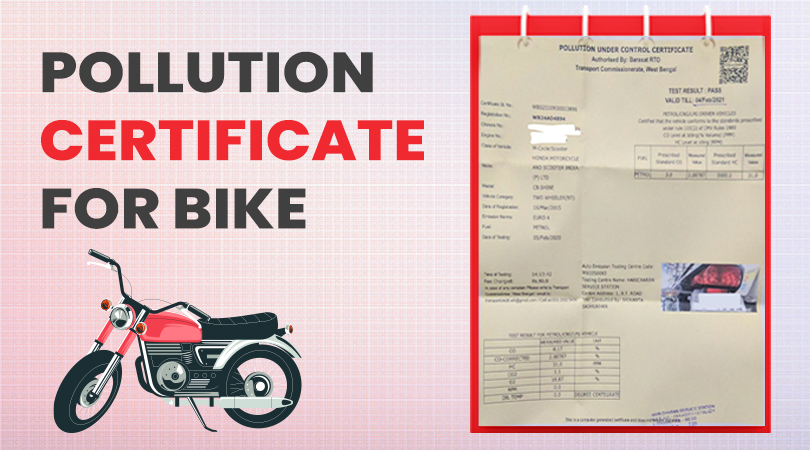It is mandatory for all vehicle owners to get a valid Pollution Under Control (PUC) certificate from an authorized PUC center before they start driving legally on public roads. This is a mandatory document that every vehicle owner (two-wheeler or four-wheeler) needs to acquire. The PUC certificate validifies that your two-wheeler’s emission level is in compliance with the pollution norms, which means that your vehicle meets the certified emission standard. This document represents the amount of carbon emission your vehicle emits. In this blog, you will learn every necessary detail about the PUC certificate, including the steps required to receive this certificate.
What is a PUCC?
PUCC stands for Pollution Under Control Certificate. This mandatory document states that your vehicle’s emission levels meet the environmental standard set by the government. You can receive your PUC certificate by visiting any authorized emission testing center in the country. The officials at the emission test center will first thoroughly examine the exhaust gas emitted by your vehicle and then issue a PUC certificate after approving the test results.
How do I get a PUC certificate as a bike owner?
There are two methods of getting a PUC certificate for your bike or car:
- The offline method: requires vehicle owners to visit the local emission test center.
- The online method: individuals can also apply for the certificate online by visiting the web portal VAHAN (Parivahan).
How do you receive your PUCC offline?
Follow these easy steps to receive your Pollution Under Control Certificate from offline test centers:
Step 1. The first step involves taking your vehicle to the nearby emission test center.
Step 2. The experts at the testing center will monitor the exhaust emission with the help of a testing device. The testing device is placed at the vehicle’s exhaust pipe to check the emission level.
Step 3. After approving the emission result, the operator will give you the PUC certificate.
Step 4. Lastly, you will need to pay the required fees to receive the PUCC.
From where can you get a PUC certificate offline?
Individuals can apply for a PUCC by visiting the following places:
- Authorized emission testing centers.
- Standalone emission testing centers. Make sure these places are correctly licensed.
- Fuel stations that have emission testing equipment.
How to get PUCC online?
Follow these simple steps to get your PUCC online:
Step 1. Go to the VAHAN portal from the website Parivahan.
Step 2. Select the option “PUC Certificate”.
Step 3. Fill in the necessary information, such as the vehicle’s registration number, the last five characters of the chassis number, and the verification code.
Step 4. Select “PUC Details”.
Step 5. Now, download the PUC Certificate.
Note: With these steps, individuals can only receive the existing PUC Certificate. However, renewal of PUC certificates cannot be done online.
What are the Emission Test procedures required to get a valid PUCC?
To issue a PUC certificate, the vehicle owner needs to visit a certified vehicle emission test center. The operator at the center will instruct the owner to follow some simple procedures, which are explained below:
Step 1. The operator will ask you to position your two-wheeler in a certain way, which you must perform according to his instructions.
Step 2. Then, the operator will take an equipment or device and insert it inside your vehicle’s exhaust pipe.
Step 3. Then, you will need to start the engine as per the instructor’s advice so that the device can monitor your vehicle’s emission level.
Step 4. The readings will be automatically displayed on the computer screen.
Step 5. Lastly, the operator will take a picture of your bike or car’s registration plate. You will need to pay the amount they charge for generating your PUCC. After all the above-mentioned steps are done, you will receive the PUC certificate.
How many kinds of emission tests are there for vehicles, and what are they?
Petrol vehicles include the following tests:
- Carbon Monoxide (CO) Test: this test is for measuring CO emissions of the vehicle and checking fuel combustion, engine efficiency as well as air intake capacity.
- Hydrocarbon (HC) Test: This test measures the unburnt fuel to check the complete combustion of the fuel by the engine.
- Carbon Dioxide (CO2) Test: it measures CO2 emissions to measure its impact on the environment.
Tests for diesel vehicles are:
- Smoke Density Test: it measures the black smoke that is emitted from the vehicle to check its fuel combustion capacity.
- Idling CO Test: This test measures CO emission during engine idling.
Tests for CNG or LPG vehicles include:
- CO Test: this checks fuel combustion efficiency.
- HC Test: this checks complete fuel combustion.
- Sound test for CNG/ LPG systems: this test is done to find leaks or damages that might increase the emission.
Conclusion:
Under the Motor Vehicle Act of 1988, every vehicle owner must possess a Pollution Under Control Certificate to become eligible to drive their vehicle on Indian roads. Therefore, regardless of the fuel type, you must take your brand-new two- or four-wheeler to the nearest test center to get a PUC certificate. Vehicle owners also have the option to get the certificate online seamlessly with a few steps. Also, remember that the PUC certificate comes with a validity date. For new bike owners, the validity period extends up to 1 year after the completion of which you need to get your PUCC renewed, which is again valid for the next six months.





































